Citroen C5 2015 (RD/TD) / 2.G Owner's Manual
Manufacturer: CITROEN, Model Year: 2015, Model line: C5, Model: Citroen C5 2015 (RD/TD) / 2.GPages: 344, PDF Size: 12.95 MB
Page 111 of 344

97
C5_en_Chap04_conduite_ed01-2014
Anti-theft protection
Electronic engine immobiliser
The key contains an electronic chip which has
a special code. When the ignition is switched
on, this code must be recognised in order for
starting to be possible.In the event of a fault, you are
informed by illumination of this
warning lamp, an audible signal and
a message in the screen.
In this case, your vehicle will not start; contact
a CITROËN dealer as soon as possible.
Starting-switching off the engine
Keep safely, away from your vehicle,
the label attached to the keys given to
you on acquisition of the vehicle.
Ignition switch
It has 3 positions:
- p osition 1 (Stop) : insert and removing
the
key,
-
p
osition 2 (Ignition on) : steering column
unlocked, ignition on, Diesel preheating,
engine running,
-
p
osition 3 (Starting) .
Ignition on position
It allows the use of the vehicle's electric
equipment or portable devices to be charged.
Avoid attaching heavy objects to the
key, which would weigh down on its
blade in the ignition switch and could
cause a malfunction.
This electronic engine immobiliser locks the
engine management system a few minutes
after the ignition is switched off and prevents
starting of the engine by anyone who does not
have the key.
Once the state of charge of the battery drops
to the reserve level, the system switches to
energy economy mode: the power supply is
cut off automatically to preserve the remaining
battery charge.
4
Driving
Page 112 of 344

98
C5_en_Chap04_conduite_ed01-2014
Starting the engine
Wait until this warning lamp goes off in the
instrument panel then operate the starter
motor by turning the key to position 3
without pressing the accelerator pedal,
until the engine starts. Once the engine is
running, release the key.
With the parking brake applied and the gearbox
in neutral or position N or P:
F
d
epress the clutch pedal fully (manual
gearbox),
or
F
p
ress the brake pedal firmly (electronic or
automatic gearbox),
F
i
nsert the key into the ignition switch; the
system recognises the code,
F
u
nlock the steering column by simultaneously
turning the steering and the key.
F
W
ith a petrol engine, operate the starter
motor by turning the key to position 3
without pressing the accelerator pedal,
until the engine starts. Once the engine is
running, release the key. Never leave the engine running in
an enclosed area without adequate
ventilation: internal combustion
engines emit toxic exhaust gases,
such as carbon monoxide. Danger of
intoxication and death.
In very severe wintry conditions
(temperatures below -23°C), to ensure
the correct operation and durability of
the mechanical components of your
vehicle, engine and gearbox, it is
necessary to leave the engine running
for 4 minutes before moving off.
In wintry conditions, the warning lamp
can stay on for a longer period. When
the engine is hot, the warning lamp
does not come on.
In certain cases, you may have to apply
more force to the steering (wheels on
full lock, for example). F
W ith a Diesel engine, turn the key to
position 2 , ignition on, to operate the
engine pre-heating system.
If the engine does not start straight
away, switch off the ignition. Wait a
few moments before operating the
starter motor again. If the engine does
not start after several attempts, do not
keep trying: you risk damaging the
starter motor or the engine. Contact
a CITROËN dealer or a qualified
workshop. In temperate conditions, do not leave
the engine at idle to warm up but move
off straight away and drive at moderate
speed.
Driving
Page 113 of 344
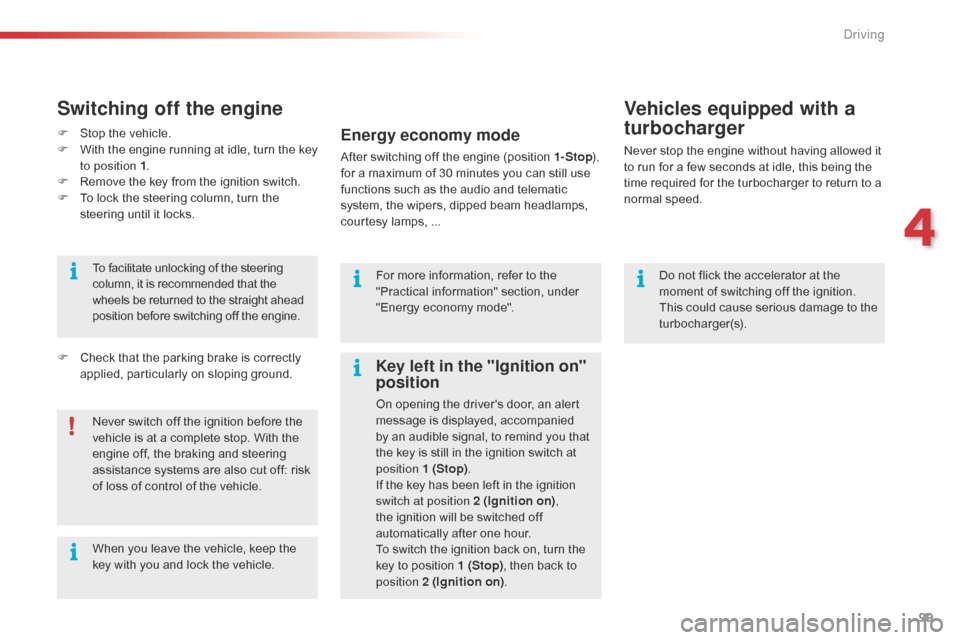
99
C5_en_Chap04_conduite_ed01-2014
Do not flick the accelerator at the
moment of switching off the ignition.
This could cause serious damage to the
turbocharger(s).
Vehicles equipped with a
turbocharger
Never stop the engine without having allowed it
to run for a few seconds at idle, this being the
time required for the turbocharger to return to a
normal speed.Energy economy mode
After switching off the engine (position 1- Stop),
for a maximum of 30 minutes you can still use
functions such as the audio and telematic
system, the wipers, dipped beam headlamps,
courtesy lamps, ...
Switching off the engine
F Stop the vehicle.
F W ith the engine running at idle, turn the key
to position 1 .
F
R
emove the key from the ignition switch.
F
T
o lock the steering column, turn the
steering until it locks.
When you leave the vehicle, keep the
key with you and lock the vehicle. To facilitate unlocking of the steering
column, it is recommended that the
wheels be returned to the straight ahead
position before switching off the engine.
Never switch off the ignition before the
vehicle is at a complete stop. With the
engine off, the braking and steering
assistance systems are also cut off: risk
of loss of control of the vehicle. For more information, refer to the
"Practical information" section, under
"Energy economy mode".
F
C
heck that the parking brake is correctly
applied, particularly on sloping ground.
Key left in the "Ignition on"
position
On opening the driver's door, an alert
message is displayed, accompanied
by an audible signal, to remind you that
the key is still in the ignition switch at
position 1 (Stop) .
If the key has been left in the ignition
switch at position 2 (Ignition on) ,
the ignition will be switched off
automatically after one hour.
To switch the ignition back on, turn the
key to position 1 (Stop) , then back to
position 2 (Ignition on) .
4
Driving
Page 114 of 344
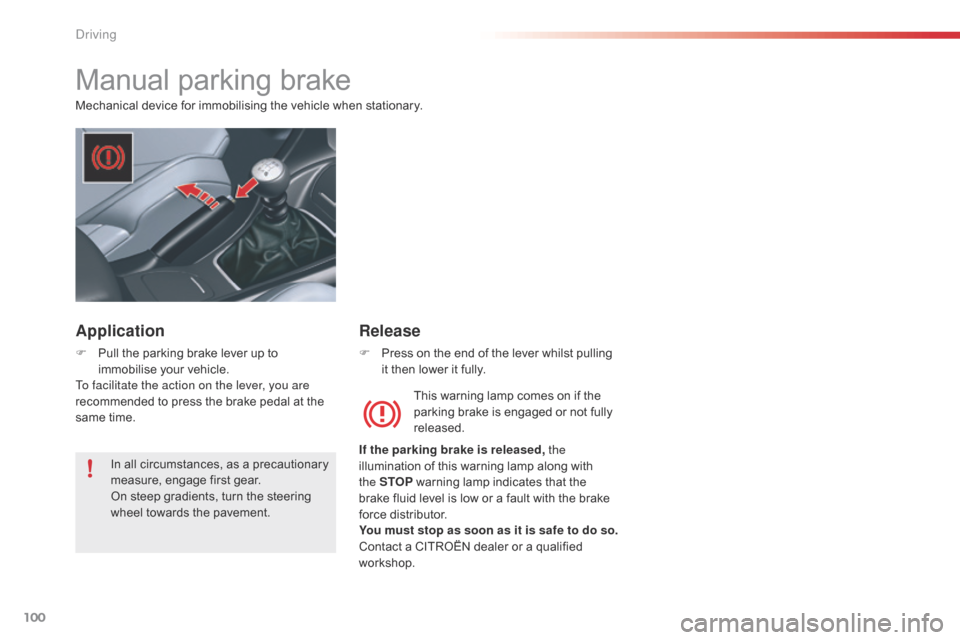
100
C5_en_Chap04_conduite_ed01-2014
Manual parking brake
Mechanical device for immobilising the vehicle when stationary.This warning lamp comes on if the
parking brake is engaged or not fully
released.
If the parking brake is released, the
illumination of this warning lamp along with
the
STOP warning lamp indicates that the
brake fluid level is low or a fault with the brake
force distributor.
You must stop as soon as it is safe to do so.
Contact a CITROËN dealer or a qualified
workshop.
Application
F Pull the parking brake lever up to immobilise your vehicle.
To facilitate the action on the lever, you are
recommended to press the brake pedal at the
same time.
Release
F Press on the end of the lever whilst pulling it then lower it fully.
In all circumstances, as a precautionary
measure, engage first gear.
On steep gradients, turn the steering
wheel towards the pavement.
Driving
Page 115 of 344
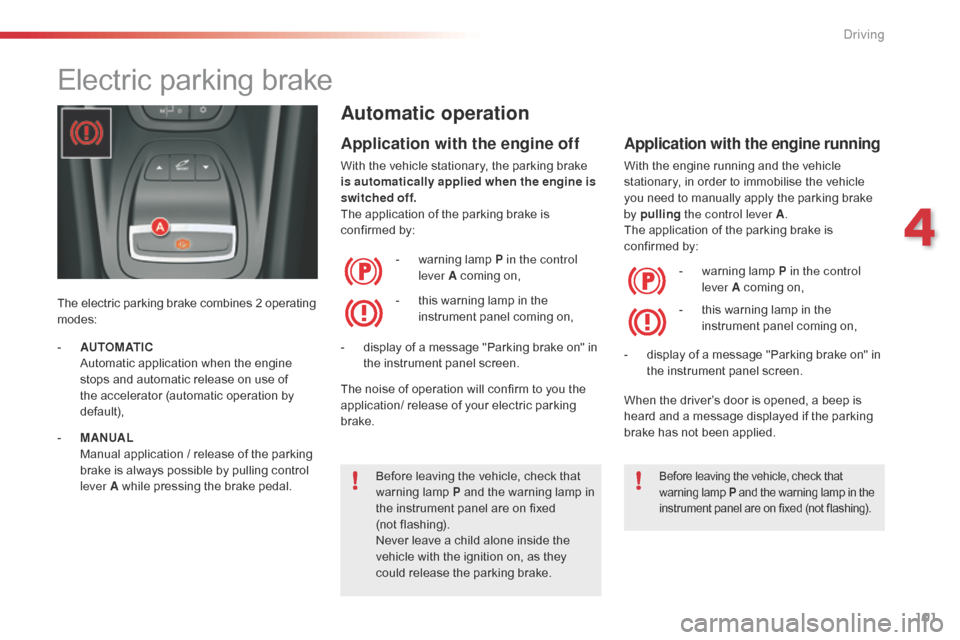
101
C5_en_Chap04_conduite_ed01-2014
Electric parking brake
The electric parking brake combines 2 operating
modes:
Automatic operation
Application with the engine off
With the vehicle stationary, the parking brake
is automatically applied when the engine is
switched off.
The application of the parking brake is
confirmed by:
Application with the engine running
With the engine running and the vehicle
stationary, in order to immobilise the vehicle
you need to manually apply the parking brake
by pulling the control lever A .
The application of the parking brake is
confirmed by:
-
w
arning lamp P in the control
lever A coming on,
-
d
isplay of a message "Parking brake on" in
the instrument panel screen. -
w
arning lamp P in the control
lever A coming on,
-
d
isplay of a message "Parking brake on" in
the instrument panel screen.
-
t
his warning lamp in the
instrument panel coming on, -
t
his warning lamp in the
instrument panel coming on,
Before leaving the vehicle, check that
warning lamp P and the warning lamp in
the instrument panel are on fixed
(not flashing).
Never leave a child alone inside the
vehicle with the ignition on, as they
could release the parking brake.
Before leaving the vehicle, check that
warning lamp P and the warning lamp in the
instrument panel are on fixed (not flashing).
- AUTOMATIC A
utomatic application when the engine
stops and automatic release on use of
the accelerator (automatic operation by
default),
-
M
ANUAL
M
anual application / release of the parking
brake is always possible by pulling control
lever A while pressing the brake pedal. When the driver’s door is opened, a beep is
heard and a message displayed if the parking
brake has not been applied.
The noise of operation will confirm to you the
application/ release of your electric parking
brake.
4
Driving
Page 116 of 344
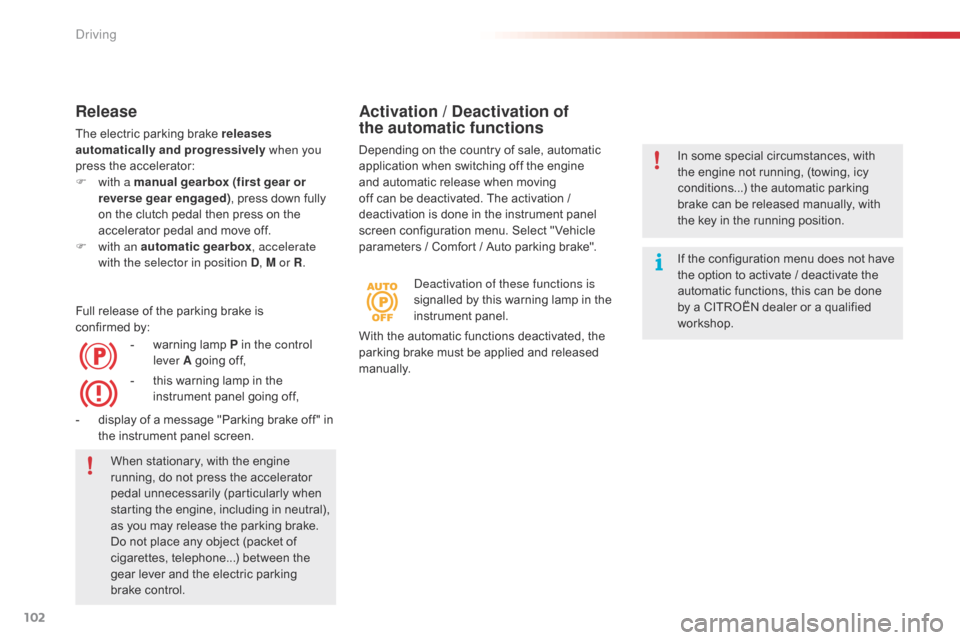
102
C5_en_Chap04_conduite_ed01-2014
Release
The electric parking brake releases
automatically and progressively when you
press the accelerator:
F
w
ith a manual gearbox (first gear or
reverse gear engaged) , press down fully
on the clutch pedal then press on the
accelerator pedal and move off.
F
w
ith an automatic gearbox , accelerate
with the selector in position D , M or R.
Full release of the parking brake is
confirmed
by:
-
w
arning lamp P in the control
lever A going off,
-
d
isplay of a message "Parking brake off " in
the instrument panel screen.
Activation / Deactivation of
the automatic functions
Depending on the country of sale, automatic
application when switching off the engine
and automatic release when moving
off can be deactivated. The activation /
deactivation is done in the instrument panel
screen configuration menu. Select " Vehicle
parameters / Comfort / Auto parking brake".
de
activation of these functions is
signalled by this warning lamp in the
instrument panel.
-
t
his warning lamp in the
instrument panel going off, In some special circumstances, with
the engine not running, (towing, icy
conditions...) the automatic parking
brake can be released manually, with
the key in the running position.
If the configuration menu does not have
the option to activate / deactivate the
automatic functions, this can be done
by a CITROËN dealer or a qualified
workshop.
With the automatic functions deactivated, the
parking brake must be applied and released
manually.
When stationary, with the engine
running, do not press the accelerator
pedal unnecessarily (particularly when
starting the engine, including in neutral),
as you may release the parking brake.
Do not place any object (packet of
cigarettes, telephone...) between the
gear lever and the electric parking
brake control.
Driving
Page 117 of 344

103
C5_en_Chap04_conduite_ed01-2014
Manual operation
Application
With the vehicle stationary, to apply the parking
brake whether the engine is running or off, pull
the control lever A .
The application of the parking brake is
confirmed by:
-
w
arning lamp P in the control
lever A coming on,
-
d
isplay of a message "Parking brake on" in
the instrument panel screen. -
t
his warning lamp in the
instrument panel coming on,
When the driver’s door is opened with the
engine running, a message is displayed
accompanied by an audible signal if the
parking brake has not been applied.
Manual application / release of the parking
brake is always possible.
Release
With the ignition on or the engine running, to
release the parking brake, press on the brake
pedal,
push then release control lever A.
The full application of the parking brake is
confirmed by: -
w
arning lamp P in the control
lever A going off,
-
d
isplay of a message "Parking brake
released" in the instrument panel screen. -
t
his warning lamp in the
instrument panel going off,
When stationary, with the engine running, do
not press the accelerator pedal unnecessarily,
as you may release the parking brake.
If you push control lever A without pressing
the brake pedal, the parking brake will not be
released and the message "Foot on brake" will
be displayed in the instrument panel.
4
Driving
Page 118 of 344
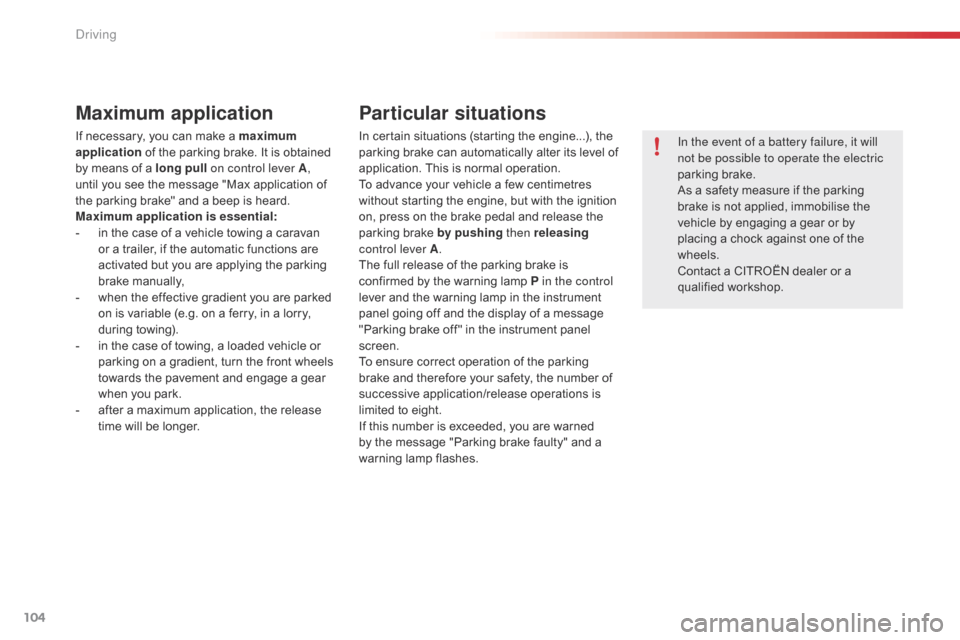
104
C5_en_Chap04_conduite_ed01-2014
Maximum application
If necessary, you can make a maximum
application of the parking brake. It is obtained
by means of a long pull on control lever A,
until you see the message "Max application of
the parking brake" and a beep is heard.
Maximum application is essential:
-
i
n the case of a vehicle towing a caravan
or a trailer, if the automatic functions are
activated but you are applying the parking
brake manually,
-
w
hen the effective gradient you are parked
on is variable (e.g. on a ferry, in a lorry,
during towing).
-
i
n the case of towing, a loaded vehicle or
parking on a gradient, turn the front wheels
towards the pavement and engage a gear
when you park.
-
a
fter a maximum application, the release
time will be longer.
Particular situations
In certain situations (starting the engine...), the
parking brake can automatically alter its level of
application. This is normal operation.
To advance your vehicle a few centimetres
without starting the engine, but with the ignition
on, press on the brake pedal and release the
parking brake by pushing then releasing
control lever A .
The full release of the parking brake is
confirmed by the warning lamp P in the control
lever and the warning lamp in the instrument
panel going off and the display of a message
"Parking brake off " in the instrument panel
screen.
To ensure correct operation of the parking
brake and therefore your safety, the number of
successive application/release operations is
limited to eight.
If this number is exceeded, you are warned
by the message "Parking brake faulty" and a
warning lamp flashes. In the event of a battery failure, it will
not be possible to operate the electric
parking brake.
As a safety measure if the parking
brake is not applied, immobilise the
vehicle by engaging a gear or by
placing a chock against one of the
wheels.
Contact a CITROËN dealer or a
qualified workshop.
Driving
Page 119 of 344

105
C5_en_Chap04_conduite_ed01-2014
If a failure of the DSC system is
signalled by the illumination of this
warning lamp, then braking stability is
not guaranteed. In this event, stability
must be assured by the driver by
repeating alternate "pull - release"
actions on control lever A.
The dynamic emergency braking
should only be used in exceptional
circumstances.
If it is not possible to immobilise the
vehicle, contact a CITROËN dealer or
a
qualified workshop.
Dynamic emergency
braking
In the event of a failure of the vehicle’s main
braking system or in an exceptional situation
(e.g. driver taken ill, under instruction, etc) pull
and hold control lever A to stop the vehicle.
The dynamic stability control system (DSC)
provides stability during dynamic emergency
braking.
If there is a fault with the dynamic emergency
braking, one of the following messages will be
displayed in the instrument panel screen:
-
"
Parking brake faulty".
-
"
Parking brake control faulty".
4
driving
Page 120 of 344

106
C5_en_Chap04_conduite_ed01-2014
SITUATIONCONSEQUENCES
1 Electric parking brake problem and display of message
"
Parking brake faulty " and the following warning
lamps: If the electric parking brake problem warning lamp and the service warning
lamp come on, position the vehicle in a safe location (on flat ground, with a gear
engaged).
2 Display of the messages "
Parking brake faulty" and
" Anti roll-back fault" and of the following warning
lamps: -
T
he automatic functions are deactivated.
-
T
he hill start assist is not available.
-
T
he electric parking brake is only available manually.
3 Display of messages "
Parking brake faulty" and "Anti
roll-back fault" and of the following warning lamp: -
M
anual release of the electric parking brake is not available.
-
T
he hill start assist is not available.
-
T
he automatic functions and manual application are still available.
If any of these instances arises, contact a CITROËN dealer or a qualified workshop as soon as possible.
Operating faults
Driving